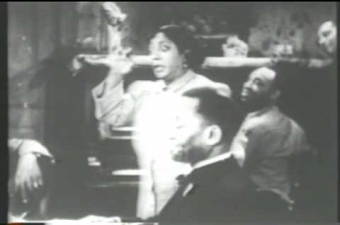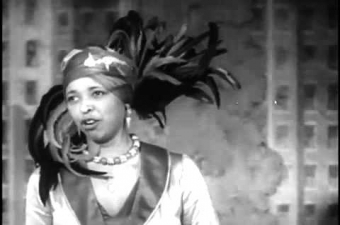Lyric Theater
201 BurgundyNew Orleans LA 70116
The Lyric Theater, billed as “America’s Largest and Finest Colored Theatre” from 1919 through 1927, was a prominent vaudeville venue, where New Orleans audiences and artists encountered the top Black entertainers of the era. The house band for seven of these years was the John Robichaux Orchestra, a contributor to the birth of jazz earlier in the 1900s, which featured some of the city’s finest musicians.
While the Lyric’s featured artists, staff, and audience were Black, the owners of the 2,000-seat house were white. The theater was an anchor of the TOBA circuit—the acronym stood for Theater Owners Booking Association, but it used mostly cramped, aging theaters, which, along with exploitative labor practices, led to cracks among performers that TOBA stood for “Tough on Black asses.”
For artists, playing the well-appointed Lyric, situated in the French Quarter’s lively Tango Belt, was a highlight on a grueling schedule. As legendary performer Josephine Baker wrote about appearing here in the early 1920s, “Huge theatre with real orchestra, many musicians: happy!”
Vaudeville shows featured a range of novelty acts—everything from comedy skits to a man picking up furniture with his teeth—but the music, provided by the first generation of blues stars, was built to last. Most notable were the “Queens,” including vocalists Ma Rainey, Mamie Smith, and Bessie Smith. The latter Smith was backed at the Lyric by New Orleans native Lonnie Johnson, the acoustic blues guitar hero, who became a standout recording artist himself.
In conjunction with her appearance at the Lyric in April, 1922, the trailblazing singer and actress Ethel Waters performed with her Black Swan Troubadours on a New Orleans radio station, becoming one of the earliest African American women to sing on the air.
While theater audiences were segregated by law (and in keeping with the wishes of co-owner Clarence Bennet), the Lyric added late-night shows on weekends for “whites only.” Vaudeville scholar Lynn Abbot notes that “Jim Crow protocol required that admission to the Midnight Frolics be ‘by invitation only,’” with invitations available at newspaper offices and hotels. This was an early example of “authentic” Black performances marketed by white businessmen to white tourists in New Orleans. The shows featured the same performers doing roughly the same material as usual, though some of the references and in-jokes crafted for Black audiences likely went over their heads.
Connecting local and national artists
From 1919 through 1926, Robichaux’s orchestra was integral to the Lyric’s success. An earlier lineup had rivaled jazz progenitor Buddy Bolden’s outfit, though the versatile Robichaux adapted to the theater, playing written scores and venturing into jazz only as a given show demanded.
Instrumentalists in the group in the 1920s included clarinetist Alphonse Picou, whose solo on “High Society” remains a fixture in traditional jazz; cornetist Andrew Kimball, a favorite of Louis Armstrong; and drummer Zutty Singleton, who would play on Armstrong’s landmark Hot Five recordings.
Another New Orleanian, Earl Palmer, who would go on to become one of the most influential drummers of all time, recalled dancing on the Lyric stage at “four or five” years old, “maybe less.” His mother and aunt were vaudeville dancers who incorporated him into their act.
The Lyric’s low prices—matinee admission started at a nickel—meant that practically everyone in town could afford to see the top Black entertainers from around the country. Armstrong went “quite often,” as did a young Mahalia Jackson, who saved pennies to see Bessie Smith, a major influence on her vocal style. Jazzman Danny Barker recalled listening to risqué songs at the Lyric of the type that he would later perform with his wife Blue Lu Barker.
Countless other New Orleans performers were influenced by shows at the Lyric, as seen in ensuing decades in the floor shows at the famed Dew Drop Inn, the nationally celebrated antics of bandleader Louis Prima, and the dance routines of Pork Chop and Kidney Stew on Bourbon Street.
The Lyric Theater’s closure and legacy
Performances at the Lyric stopped abruptly in late 1927. Numerous secondary sources attribute this to a fire, but, in fact, the building was demolished by choice. Abbot found a likely explanation in a report from the Chicago Defender: “The house has been losing money for the past two years, notwithstanding that it plays the best Colored attractions on the road.” The demolition followed a years-long crackdown on nightlife in the Tango Belt, where purveyors of bootleg liquor and prostitution ran afoul of Prohibition-era reformers.
In early 1928, as the city’s Association of Commerce put it, “Progress of New Orleans has forced the removal of another of the city’s landmarks.” The theater was torn down to make way for a multi-story garage (“Lyric Parking Place”) to accommodate “the growing volume of motor cars pouring into the commercial area” off Canal Street.
Music had played on the site since 1892, when Henry Wenger, whose concert saloon had been the first such establishment on Bourbon Street, established a theater here. The facility rebranded as the Lyric in 1904, presenting vaudeville and motion pictures to white audiences until new owners kicked off its fabled run in 1919.
One piece of the Lyric’s golden age survived demolition: its pipe organ found a new home in Mount Calvary Lutheran Church near the Fair Grounds, where it was heard every Sunday for decades (the church was converted into a residence in 2017).
These days, the Lyric is perhaps best remembered as the setting of the hit musical “One Mo’ Time,” conceived, directed by, and starring New Orleanian Vernel Bagneris. The show opened in 1978 at the Toulouse Street Theater, a few blocks from where the Lyric once stood, featuring vaudeville-era songs and a plot that addressed the backstage struggle of TOBA artists. The following year it opened at the Village Gate in New York, where it won popular and critical acclaim. From there it went worldwide, and was revived on Broadway in 2002.
The “One Mo’ Time” cast album was nominated for a Grammy, and the production showcased New Orleans musicians including vocalists Topsy Chapman, Thais Clark, “Lady BJ” Crosby, Wanda Rouzan, and Lillian Boutté. In the orchestra, trumpeter Mark Braud and tubist Walter Payton played arrangements by Swede-turned-New Orleans bandleader Lars Edegran.
Videos

A medley from One Mo' Time, the musical set in the Lyric Theater.

Bessie Smith, who appeared at the Lyric Theater, performs "St. Louis Blues."
Video by vintage video clips.
Bessie Smith, who appeared at the Lyric Theater, performs "St. Louis Blues."

Mamie Smith, who appeared at the Lyric Theater, performs "Harlem Blues."

Ethel Waters, who appeared at the Lyric Theater, performs "Birmingham Bertha."
Video by UnderGroundOldSoul.
Ethel Waters, who appeared at the Lyric Theater, performs "Birmingham Bertha."
Images












